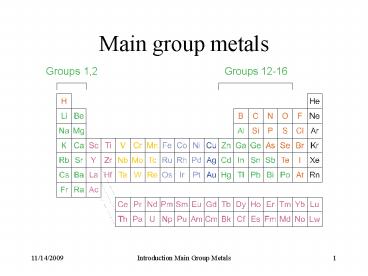Main group metals - PowerPoint PPT Presentation
1 / 14
Title:
Main group metals
Description:
for more electropositive elements, deprotonation and nucleophilic attack are faster ... For electropositive elements: M has a low electron affinity ... – PowerPoint PPT presentation
Number of Views:103
Avg rating:3.0/5.0
Title: Main group metals
1
Main group metals
2
Main group metal compounds
- Structures
- s bonds and 3c-2e (or even 4c-2e) bonds
- Synthesis
- the first M-C bond
- Reactivity
- auxiliaries in organic synthesis
- source of organic groups for transition metals
3
Structures
- Not always 8/18 e
- "Too many" electrons if
- large atomic radius
- electropositive elements
- small ligands
- chelate structures
- "Too few" electrons for
- small atomic radius
- less electropositive elements
- 8/18 e "preference" rather than "rule"
4
Structures
- Strong preference for s-donor groups
- but Cp is often p-bound
- Electropositive metals often 3c-2e
hydrides/alkyls - as "stopgap"
5
Reactivity as Nucleophile
- Addition to polar CX bonds
- (CO, CN, CºN)
- Substitution at sp2 carbon
- (often via addition)
6
Reactivity as Nucleophile
- Substitution at sp3 carbon does occur
- but is far less easy
- and often has a multistep mechanism
- Substitution at other elementsoften easy for
polar M-X bonds - (Si-Cl, B-OMe)
7
Reactivity as Base
- Elimination
- Metallation
- chelate effect more important than inductive
effect!
8
Reactivity as Base
- Metallation (2)
- Only acidic C-H bonds (acetylenes,
cyclopentadiene) react without "assistance" by
coordinating groups
9
Reactivity as Base
- Reaction with acidic X-H bonds
- also with amines, amides etc (LDA!)
- deprotonating X-H bonds is kinetically much
easier than C-H bonds
10
Reactivity as Reductor
- b-hydrogen transfer
- mainly for Al
- for more electropositive elements, deprotonation
and nucleophilic attack are faster - for less electropositive elements, often no
reaction
11
Reactivity as Reductor
- Single-electron transfer (SET)
- For electropositive elements
- M has a low electron affinity
- the M-C bonding orbital is high in energy
- SET from there to another molecule is easy
12
Synthesis
- Direct synthesis
- only for electropositive metals
- Transmetallation
- M more electropositive than M'
13
Synthesis
- Metal-halogen exchange
- mainly for R alkyl, R' aryl
- Addition of hydrides to olefins
- mainly for B, Al
14
Synthesis
- Metallation of C-H bonds
- often assisted/directed by chelate effect































